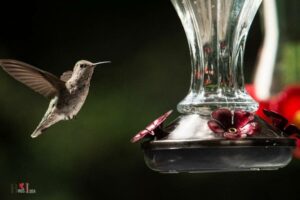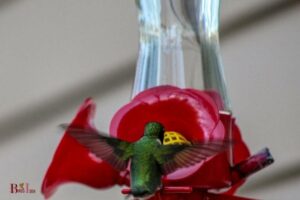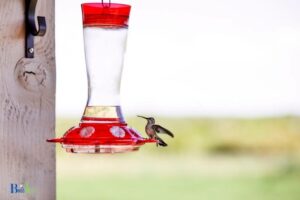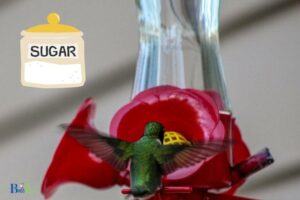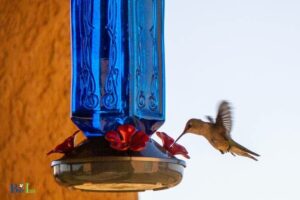How To Hang Hummingbird Feeder On Deck?
Hanging a hummingbird feeder on your deck is a delightful way to attract these beautiful birds to your outdoor living space, providing them with a source of nourishment and giving you a chance to observe them up close.
To hang a hummingbird feeder on your deck, you must choose an effective location, select an appropriate hanging method, and ensure the feeder is properly filled and maintained.
Regular care and maintenance of your feeder, including cleaning and refilling with fresh nectar, will keep hummingbirds returning to your deck and provide you with endless opportunities to observe and admire these fascinating creatures.
6 Steps: Hang Hummingbird Feeder On Deck
| Step | Instructions |
|---|---|
| 1 | Choose a location on your deck that is easily visible, near flowers, and partially shaded. |
| 2 | Select a sturdy hook or bracket that is strong enough to support the weight of a filled feeder. |
| 3 | Attach the hook or bracket to the deck railing, post, or overhead beam, following its instructions. |
| 4 | Fill the hummingbird feeder with nectar and securely close it to prevent leaks. |
| 5 | Hang the feeder on the hook or bracket, ensuring it is level and securely in place. |
| 6 | Clean and refill the feeder regularly to maintain a steady food supply for the hummingbirds. |
Key Takeaway
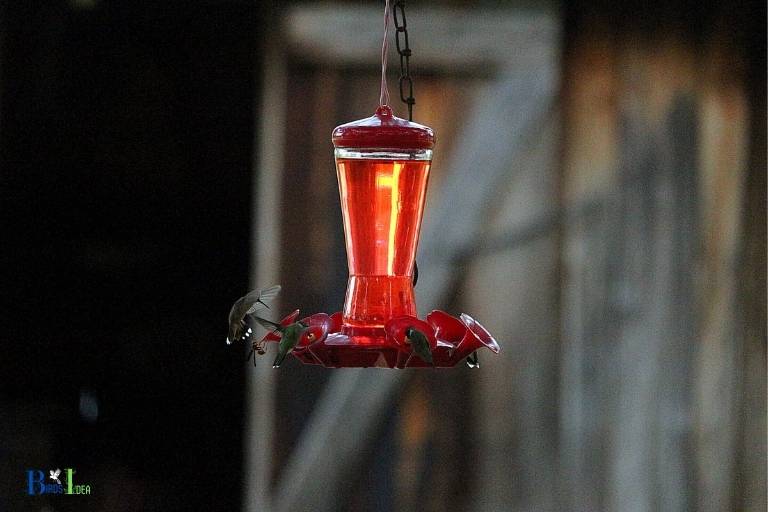
Five Facts About: Hummingbird Feeder On Deck
What is the Best Location to Hang a Hummingbird Feeder on a Deck?
The best location to hang a hummingbird feeder on a deck is a spot that provides easy access for the birds while also offering some protection from potential predators.
Consider these factors:
- Choose a shaded area: Hummingbirds prefer to feed in cooler, shaded spots, and the nectar in the feeder lasts longer when it’s not exposed to direct sunlight.
- Keep it close to flowers: Hummingbirds are attracted to bright, colorful flowers, so hanging the feeder near a flowerbed or flower pots increases the chances of attracting them to your deck.
- Provide cover: Hang the feeder near shrubs or trees, giving the birds a place to hide from predators and rest between feedings.
- Ensure visibility: Position the feeder in an area easily visible from your house so you can enjoy watching the hummingbirds visit.
“Hummingbirds are attracted to bright colors and sweet nectar, so make sure your feeder is colorful and filled with fresh sugar water.”
birdsidea
How to Attach a Hummingbird Feeder to a Deck?
Attaching a hummingbird feeder to your deck is a simple process that ensures these lovely creatures have food while enhancing the aesthetics of your outdoor space.
To hang your hummingbird feeder on the deck, you’ll require a clamp-on deck hook or deck rail hanger.
Here are the steps to follow:
- Purchase a suitable deck hook or deck rail hanger specifically designed to hold bird feeders.
- Choose a location on the deck that is easy to access for refilling and cleaning but also offers a clear view for birdwatching.
- Follow the instructions on the deck hook or hanger packaging to properly attach it to the deck railing.
- Fill your hummingbird feeder with nectar or a sugar-water solution.
- Hang the feeder on the hook or hanger, ensuring it’s stable and secure.
In summary, attaching a hummingbird feeder to your deck involves purchasing a deck hook or hanger, selecting the ideal location, and securely fastening the feeder to the deck.
With these simple steps, you can create a welcoming space for hummingbirds and enjoy watching them as they visit your deck.
Tips for Maintaining a Hummingbird Feeder on a Deck
Maintaining a hummingbird feeder on a deck requires careful planning and regular upkeep to ensure these delicate birds have a safe and consistent source of nourishment.
Select a feeder with an ant moat, bee guards, and easy-to-clean features for optimal results. Hang the feeder at least 5 feet above the ground and close to colorful flowers or plants to attract hummingbirds.
Tips for maintaining a hummingbird feeder on a deck:
- Choose a suitable location for the feeder: away from wind and direct sunlight but visible to hummingbirds.
- Clean the feeder thoroughly, at least once a week, to prevent mold and bacteria buildup.
- Refill the feeder with fresh nectar frequently, especially during hot weather.
- Use a 4:1 ratio of water to sugar for homemade nectar, avoiding honey or artificial sweeteners.
- Monitor the feeder for any signs of wear or damage, and replace it as needed.
- Plant hummingbird-friendly flowers nearby to offer an additional source of food and promote the presence of these birds.
What to Do if Birds are Not Visiting the Hummingbird Feeder on a Deck?
If birds are not visiting the hummingbird feeder on a deck, there might be certain factors discouraging their presence.
To attract more birds and increase the chances of them visiting the feeder, consider implementing these changes:
- Location: Ensure the feeder is hung in an area with less human activity and away from predators such as cats and squirrels.
- Cleanliness: Regularly clean the feeder and replace the nectar to maintain freshness and avoid mold growth.
- Nectar Recipe: Use a 4:1 ratio of water to sugar for the nectar and avoid adding artificial colors.
- Feeder Design: Choose a brightly colored feeder, preferably red, as hummingbirds are drawn to bright colors.
- Timing: Hang the feeder early in the season when hummingbirds are migrating and looking for food sources.
- Additional Attractions: Plant flowers and provide water sources nearby to create a more inviting habitat for the birds.
Conclusion
In conclusion, hanging a hummingbird feeder on a deck is an easy and enjoyable task that can attract beautiful birds to your outdoor space.
To ensure success, gather the necessary supplies, choose a good location, and attach the feeder securely. Regular maintenance is also important to keep your feeder clean and safe for the birds.
If you find that birds are not visiting your feeder, try adjusting the location or switching up the nectar recipe. With a little patience and diligence, you can create a welcoming environment for these charming creatures right on your own deck.
TL;DR:
- Hanging a hummingbird feeder on a deck is easy and enjoyable.
- Gather necessary supplies, choose a good location, and attach the feeder securely.
- Regular maintenance is important for keeping the feeder clean and safe.
- Adjust location or nectar recipe if birds are not visiting the feeder.
Action List:
- Gather necessary supplies
- Choose a good location
- Attach the feeder securely
According to the National Audubon Society, hummingbirds can fly at speeds up to 60 miles per hour and beat their wings up to 80 times per second.
birdsidea
FAQ for Hang Hummingbird Feeder On Deck
How do I hang a hummingbird feeder on my deck?
What type of hummingbird feeder should I use?
How often should I refill the hummingbird feeder?
Where should you not hang a hummingbird feeder?
When it comes to hanging hummingbird feeders, it’s essential to choose a suitable location. While some spots may attract these lovely birds, others may not be safe or healthy for them.
Here are a few places to avoid when hanging a hummingbird feeder:
- Near windows or mirrors that may cause birds to collide and hurt themselves.
- In direct sunlight or areas with intense heat that may spoil the nectar or cause dehydration in birds.
- Close to outdoor pets or places where predators may lurk, like bushes or trees.
To provide hummingbirds with the best environment and reduce the risk of accidents, choose a shaded, peaceful spot for your feeder. Also, keep it clean and refill it with fresh nectar every few days to ensure they stick around for a while.
How do you hang a homemade hummingbird feeder?
To hang a homemade hummingbird feeder, the process is similar to hanging a store-bought feeder.
Here are the steps you can follow:
- Choose a location that is easily accessible for refilling and cleaning but away from windows and doors.
- Look for a sturdy, stable spot to hang the feeder, such as a branch or hook.
- Securely hang the feeder using a metal wire, rope or a hook.
- Make sure the feeder is level and stable, so the nectar doesn’t spill out.
- Fill the feeder with hummingbird nectar and wait for your feathered friends to come by!
If your feeder doesn’t have a built-in ant moat, you can place a shallow dish of water near the feeder to deter ants. Also, clean your feeder regularly to keep it free of mold and bacteria, which can harm the hummingbirds.
How high should I hang a hummingbird feeder?
To attract hummingbirds to your yard, the height at which you hang the feeder is important.
Here are some tips on how high you should hang a hummingbird feeder:
- Hang the feeder at eye level for optimal viewing of hummingbirds
- The bottom of the feeder should be at least 4-5 feet off the ground to avoid easy access for predators
- Make sure the feeder is easily accessible for refilling and cleaning
- Hang the feeder in a shaded spot to prevent nectar from spoiling quickly
So for those looking to hang a humingbird feeder on their deck, it is recommended to hang it at eye-level and at least 4-5 feet off the ground.
Make sure to select an easily accessible and shaded spot for more bird traffic.
How do you hang a hanging bird feeder?
To hang a hanging bird feeder, you will need to follow a few simple steps:
Choose the right location: Identify a spot in your yard or garden where you want to hang the bird feeder. Ensure that it’s easily accessible to birds but out of reach of squirrels.
Install a hook: Install a sturdy hook or bracket on the spot you selected. It should be strong enough to hold the weight of the bird feeder.
Attach the bird feeder: Depending on the type of feeder you have, you can hang it using a wire or cord. Make sure it’s securely attached to the hook or bracket.
Fill up the feeder: Once the bird feeder is securely hung, fill it up with birdseed or any other bird food you want to offer.
Choosing the right location is crucial to attract birds to your feeder. A spot that’s visible and easy to access for birds will help increase the chances of them finding your feeder and coming back for more.
Additionally, a location that’s not easily accessible to squirrels will ensure that your bird feeder remains accessible to birds and undamaged.
Where is the best place to hang a bird feeder?
When it comes to hanging a bird feeder, location is crucial. The best place to hang a bird feeder is somewhere that is easily accessible for birds but also safe from predators.
Here are some tips for finding the perfect spot:
- Hang the feeder in a visible location that is easy for birds to spot.
- Choose a spot away from busy windows or doors to minimize bird collisions.
- Hang the feeder at least 5 feet off the ground to deter cats and other predators.
- Place the feeder near natural cover, such as trees or bushes, to provide shelter for the birds.
- Keep the feeder at least 10 feet away from any birdhouses to avoid territorial conflicts.
By following these tips, you can ensure that your feathered friends have a safe and convenient place to eat. Remember to keep the feeder clean and well-stocked, and you’re sure to attract a wide variety of beautiful birds to your yard.
What can I use to hang a bird feeder?
There are different options you can use to hang a bird feeder, and the method may vary depending on the type of feeder and location.
Here are some commonly used materials and tools:
- Hooks: You can use a simple screw-in hook or a specialized bird feeder hook that attaches to a pole or wall. Make sure the hook is sturdy enough to hold the weight of the feeder and won’t swing in the wind.
- Hangers: Some feeders come with built-in hangers, such as chains or ropes. You can also buy hangers separately and attach them to the feeder using clips or knots.
- Poles: If you prefer to place the feeder away from trees or buildings, you can use a metal or wooden pole. Make sure it’s tall enough to keep the feeder out of reach of predators like cats or squirrels.
- Adhesives: In some cases, you may be able to attach the feeder to a window or glass surface using suction cups or clear adhesive strips. However, this may not be a reliable option if the feeder is heavy or if the weather is windy.
Whatever method you choose, make sure the feeder is easy to access for refilling and cleaning, and avoid placing it near a busy area

